

 中文摘要:
中文摘要:
目的:探讨甲状腺激素水平与子痫前期患者血流动力学指标间的相关性。方法:选取2015年6月—2016年1月南京医科大学附属南京妇幼保健院待产分娩的141例单胎妊娠的孕妇,分为正常妊娠组(NP,39例)、子痫前期组(PE,79例)、妊娠期高血压组(NIH,23例)。检测3组孕妇的促甲状腺激素(TSH)、血清游离甲状腺素(FT4)、总蛋白(TP)、白蛋白(ALB)、总胆固醇(TC)、三酰甘油(TG)的水平。采用无创血流动力学监测系统检测3组孕妇的血流动力学指标,包括心率(HR)、平均动脉压(MAP)、收缩压(SBP)、舒张压(DBP)、心脏指数(CI)、心输出量(CO)、每搏量(SV)、周围血管阻力(SVR)、周围血管阻力指数(SVRI)、净射血时间百分率(ET%)的变化。结果:(1)PE组TSH水平较NP、NIH组明显增高(P〈0.05);PE组FT4水平与NP、NIH组无明显差异(P〉0.05);(2)PE组与NP、NIH组相比TP、ALB明显降低(P〈0.05);PE组与NP、NIH组相比TC明显增高(P〈0.05);PE组与NP、NIH组相比TG无明显改变(P〉0.05)。(3)PE组与NP、NIH组相比:HR明显降低(P〈0.05),SBP、MAP、SVR、DBP、SVRI明显增高(P〈0.05)。PE组与NP组相比:ET%、CO、CI明显下降(P〈0.05)。(4)TSH与TC呈弱正相关(r=0.259 7,R-2=0.002,P〈0.05)。TSH与TP和ALB呈弱负相关(r分别为-0.222 5和-0.367 2,R-2分别为0.011和0.134,P〈0.05)。FT4与TP和ALB呈弱正相关(r分别为0.171 3和0.233 8,R-2分别为0.029和0.054,P〈0.05)。(5)TSH与MAP和SBP呈弱正相关(r分别为0.195 4和0.198 2,R-2均为0.030,P〈0.05),FT4与ET%和HR呈弱正相关(r分别为0.166 2和0.175 7,R-2分别为0.027和0.030,P〈0.05)。结论:子痫前期孕妇常合并甲状腺功能减退,故有必要在妊娠期进行甲状腺激素水平的检查;TSH升高与子痫前期的发生具有一定相关性,TSH的变化可为子痫前期早期诊断和治疗?
 英文摘要:
英文摘要:
Objective: To investigate the correlation between hypothyroidism and hemodynamic parameters in pre-eclampsia(PE). Methods: 141 singleton pregnant women from June 2015 to January 2016 in Nanjing Maternity and Child Health Care Hospital were selected and classified into following groups: normal pregnancy group(39 cases), PE group(79cases) and pregnancy-induced hypertension group(23 cases). Each woman′s thyroid stimulating hormone(TSH), serum free thyroxine(FT4), total protein(TP), albumin(ALB), total cholesterol(TC), triglyceride(TG) levels were tested and compared.Noninvasive hemodynamic monitoring was performed for all patients testing the heart rate(HR), mean arterial pressure(MAP),systolic blood pressure(SBP) and diastolic blood pressure(DBP), cardiac index(CI), cardiac output(CO), stroke volume(SV), systemic vascular resistance(SVR), systemic vascular resistance index(SVRI) and ET% changes. Results:(1)The TSH of the participants in PE group, compared with those of the other groups, was significantly increased(P〈0.05); The FT4 of the participants in PE group, compared with those of the other groups, was not significantly different(P〈0.05);(2)The TP and ALB of the participants in PE group, compared with those of the other groups, was significantly decreased(P〈0.05); The TC of the participants in PE group, compared with those of the other groups, was significantly increased(P〈0.05); The TG of the participants in PE group, compared with those of the other groups, was not significantly different(P〈0.05);(3)The HR of the participants in PE group, compared with those of the other groups, was significantly decreased(P〈0.05); the SBP, MAP, SVR,DBP and SVRI of the participants in PE group, compared with those of the other groups, were significantly increased(P〈0.05);The ET%, CO and CI of the participants in PE group, compared with those of the other groups, were significantly decrea
 同期刊论文项目
同期刊论文项目
 同项目期刊论文
同项目期刊论文
 期刊信息
期刊信息
